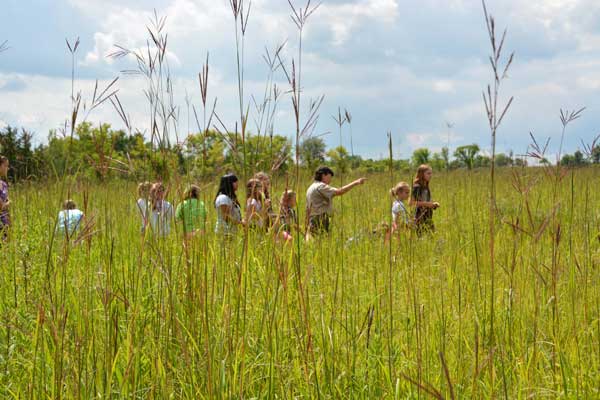Introducing Afton State Park Staff: Linda Radimecky
By Deborah Locke, DNR Information Officer
When you visit a state park or trail, you may encounter an employee wearing a light-colored uniform. What does that uniform signify?
Afton State Park assistant supervisor Linda Radimecky says that to some park visitors, the uniform signifies law enforcement. She said it’s not unusual for someone to come up to her and ask, “Are you a cop?”
To others, the uniform signifies the wearer as someone on staff who has answers to questions about the parks and everything in them. So, the uniform has a dual purpose – protection of natural resources and education for the visiting public.
As an example of protection, the COVID pandemic has brought thousands of new visitors to state parks. A few visitors don’t follow the rules, which exist to protect the environment. For example, some visitors insist on walking off trail, and making their own paths. When park visitors walk anywhere, they feel like walking, it packs the soil, which impacts plant and soil health. When a park naturalist or supervisor asks them to return to the paved trail for their walk, it’s a form of enforcement, and of education.
Radimecky, a 30-year veteran of the Department of Natural Resources Parks and Trails Division, has always had the same goal no matter which park she’s at. Her job is to educate visitors to a point where they want to become stewards and protectors of the parks. After developing an attachment to the park or trail, some visitors may join ”friends” groups and help as volunteers, and some may donate money for special projects.
The idea is to make park visitors supportive and in turn, pass that interest along to their younger relatives and friends so a new generation of Minnesotans comes along to care for and visit the parks. For Radimecky, her interest in the outdoors started early with visits to her grandparent’s homes in central Minnesota at age 7.
“At the farm in the fall we walked down an old road between the two homesteads where my grandparents and great-grandparents lived,” she said. “I noticed the trees and the way leaves crunched underfoot in the fall, and the tall grass. I always enjoyed those walks.”
The interest evolved to a decision to study nature: wildlife, plants, and trees. She pursued a B.S. degree in natural history and environmental biology from Saint May’s University in Winona, Minn. Senior year, during the third day of an internship at the Wood Lake Nature Center in Richfield, Radimecky was told that the naturalist had called in sick, preschoolers were on their way to the Center, and she and another intern would lead the group. She learned fast that she had a knack for teaching.
“With little kids, you don’t have to know a lot more than they do,” she said. “Their attention spans are short, so you show them something, and then show them something else. How much fun is that?”
She worked seasonal naturalist jobs at several parks before accepting a job as naturalist at Afton State Park near Hastings, Minn. Over the years as a naturalist, she taught skills to thousands of park visitors, from shooting an arrow to fly fishing.
Each day Radimecky puts on her uniform, which is a very tangible reminder of her job: protection of natural resources. The two may seem antithetical: protection of public land and recreational opportunities on public land. But the two coincide well when the public understands that it, too, has a role to play in preservation and protection, she said. In short, follow the rules, starting with do no harm to the environment. And return often to visit and recreate.
“Our job is easier when people buy into protecting the parks and trails,” Radimecky said. “We want them to become stewards.

























